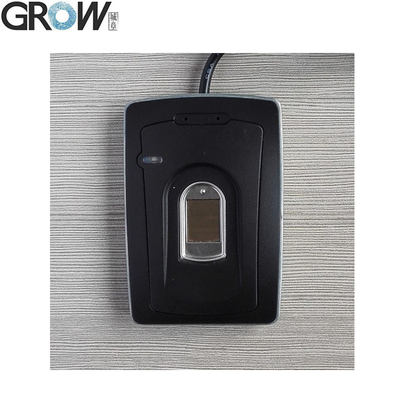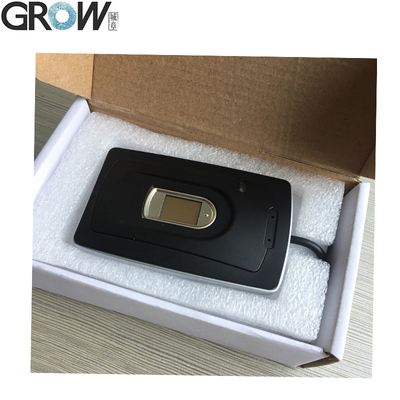Description
R101SN Capacitive USB Fingerprint Reader
R101SN's fingerprint collecting chip is FPC1020.
Material:Zinc alloy pedestal
The thickness is only 1.3 cm! R101SN outstandingly features self-learning function. During the fingerprint verification process,the latest collected fingerprint features would be integrated into the fingerprint database automatically so that the users would obtain better and better fingerprint verification result.
·High performance fingerprint reader for precise authentication with PC or network security
·Excellent adaption for dry, wet, harsh fingerprint
·USB interface for high speed communication
·Windows98,Me,NT4.0,2000,XP,Vista WIN7,Android support
·Outstanding authentication performance combined with SDK
·Adopts zinc alloy and well protect the fingerprint sensor
·High speed fingerprint identification algorithm engine
·Self study function
·Fingerprint feature data read/write functions
·Get Feature Data of Captured fingerprint and Verify/Identify Downloaded Feature with Captured fingerprint
·Identify Downloaded Feature with Captured fingerprint
·Security Level setting
Specifications
·Interface: USB
·Dimension (L*W*H): 83*55*13 mm
·Fingerprint capacity: 1000
·Resolution: 508 DPI
·Voltage: 5V
·Scanning Speed: < 0.2 second
·Verification Speed: < 0.3 second
·Matching Method: 1:1; 1 :N
·FRR (False Rejection Ratio): ≤0.01%
·FAR (False Acceptance Ratio): ≤0.0001%
·Antistatic capacity: 15KV
·Abrasive resistance intensity: 1 million times
·Work environment: -25°C ---55°C
·Work Humidity: 10-90%
Files
·Support Windows98,Me,NT4.0,2000,XP,Vista WIN7,Android
·Provide Free SDK Files
Fingerprint Sensor Duel: Capacitive Sensor and Optical Sensor
In today's rapidly advancing technology, fingerprint recognition technology has become an indispensable part of our daily lives. From the convenient unlocking of smartphones to the security protection of high-end access control systems, the presence of fingerprint sensors is indispensable. Among them, capacitive sensors and optical sensors, as the two mainstream fingerprint recognition technologies, each occupy a place in the market with their unique advantages.
Capacitive sensors, a veteran in the field of fingerprint recognition, are known for their high precision and fast response. Its working principle is based on bioelectricity, capturing fingerprint information by measuring the small capacitance difference formed between the finger and the sensor. When the finger touches the surface of the sensor, the ridges and valleys of the fingerprint will form different capacitance values with the sensor. These small differences are captured by the sensor and converted into digital signals, thereby constructing a complete fingerprint image. This process is fast and precise, like an experienced painter using delicate brushstrokes to outline every detail of a fingerprint.
The advantage of capacitive sensors lies in their high sensitivity and fast response. It can maintain high recognition accuracy even when the fingers are wet or the fingerprints are slightly damaged. In addition, capacitive sensors have strong resistance to dirt and grease, which can reduce recognition failures caused by finger contamination to a certain extent. This has made capacitive sensors widely used in devices such as smartphones that require fast and accurate unlocking.
However, capacitive sensors are not omnipotent either. It is sensitive to changes in the external environment, such as temperature, humidity, and static electricity, which may affect its recognition performance. Under extreme conditions, such as fingers being too dry or wet, the recognition performance of capacitive sensors may be affected to some extent. In addition, for users with poor fingerprint quality, such as the elderly or those with severe fingerprint wear, the recognition effect of capacitive sensors may not be satisfactory.
In contrast, optical sensors are known for their high adaptability and wide range of application scenarios. It uses light to illuminate the surface of fingerprints and constructs fingerprint images by capturing differences in reflected light. This technology is not only suitable for dry fingers, but also maintains a high recognition rate in wet or heavily stained situations. The advantage of optical sensors lies in their good adaptability to users with poor fingerprint quality. Even if the fingerprint is shallow or severely worn, the recognition accuracy can be improved by adjusting the lighting and image processing algorithms.
In application scenarios such as access control systems and attendance machines that require complex environments, optical sensors have gained widespread recognition for their excellent adaptability and stability. However, optical sensors are not without defects. It is sensitive to changes in lighting environment, such as strong or low light environments, which may affect recognition performance. In addition, optical sensors may be slightly slower than capacitive sensors in recognition speed because they require a certain amount of time to capture and process light information.
In summary, capacitive sensors and optical sensors have their own advantages and play their respective roles in different application scenarios. When choosing a fingerprint sensor, we need to consider the specific usage environment, user group, and security needs comprehensively. Only by choosing the appropriate sensor technology can we ensure the stability and accuracy of the fingerprint recognition system, providing a safer and more convenient guarantee for our daily life.
With the continuous advancement of technology and changes in market demand, capacitive sensors and optical sensors are also constantly developing and improving. In the future, we have reason to believe that these two technologies will continue to shine in the field of fingerprint recognition, bringing us a more intelligent, convenient, and secure experience.

 Your message must be between 20-3,000 characters!
Your message must be between 20-3,000 characters! Please check your E-mail!
Please check your E-mail!  Your message must be between 20-3,000 characters!
Your message must be between 20-3,000 characters! Please check your E-mail!
Please check your E-mail! 



















